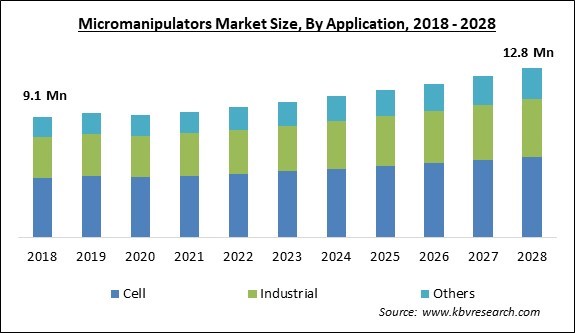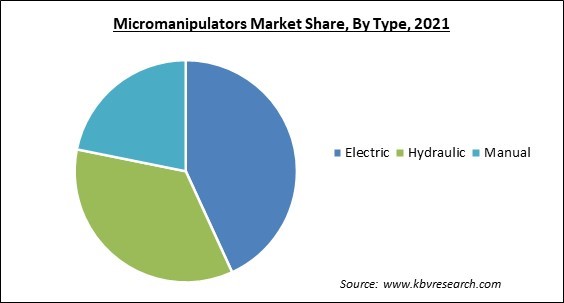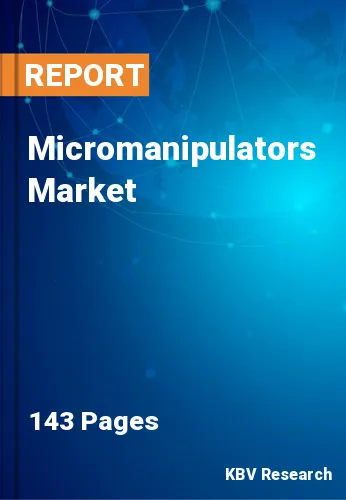The Global Micromanipulators Market size is expected to reach $12.8 million by 2028, rising at a market growth of 4.4% CAGR during the forecast period.
Micromanipulation by robots is a relatively new field. Fundamental physics, sensing, actuation, control approaches, toolsets and systems, and, most significantly, a community have all been developed and evolved over three decades. In addition, micromanipulators are also utilized in biological research and microelectronics to position test probes onto tiny to medium scale integrated circuits and hybrid devices. Mechanical levers, hydraulic pistons connected by tubes containing non-compressible fluid, electronic stepper motors or linear actuators, or a combination of these approaches in one instrument can all be used to reduce movement. To provide coarse and fine placement, mechanisms with distinct ranges of movement or variable reduction ratios may be combined in one instrument.
Micromanipulators are frequently used alongside microscopes. One or more micromanipulators may be attached to a microscope stage or solidly mounted to a bench next to a microscope, relied on the application. Human intracytoplasmic sperm injection is a common application of micromanipulation. Under the direct physical direction of an embryologist, a spermatozoon measuring 3 to 5 micrometers wide is injected into an oocyte of roughly 100 micrometers in diameter. A tool holder positioned on the manipulator's output holds a disposable glass micropipette and can be modified to accommodate various tool sizes along with the angle at which the tool is held.
When looking into micromanipulators, there are several types of movement details to examine. The micromanipulator's resolution is measured in micrometers per step, which is the smallest unit of movement it can achieve. The entire travel distance, also known as the working range, refers to the distance that the micromanipulator may move the instrument its holding. Users will undoubtedly notice differences in maximum travel speeds, which is the fastest the instrument handled by the micromanipulator can travel. As mentioned, the working range and maximum speed of travel may differ for different diameters or fine and coarse settings.
For regulating larger and smaller movements, certain micromanipulators intended for utilization with microscopes combine coarse and fine movements in one instrument. Under the low-power objective, the researcher can locate an instrument such as a micropipet in the microscope's field of vision, move the micropipet to the desired location of the specimen, center it under the field of view, and afterward switch to the high-power objective. Fine movement control is required here for small, controlled motions like softly nearing a cell for patch-clamp recordings or inserting nuclear material into a cell.

The pandemic had a major influence on the comprehensive market for micromanipulators. The micromanipulators market has suffered a setback, owing to the postponement of surgical procedures. With the development of the pandemic, hospital facilities were more concentrated on COVID patients, and other medical activities were shut down as a result of the haste to treat symptoms and facilitate vaccination throughout the globe. Moreover, delays in manufacturing units had an impact on the market's growth. Additionally, with COVID-19 cases on the decline, the market is expected to overcome the challenges and thrive during the forecast period.
Women and men who are unable to conceive after one year of intercourse without taking contraception or who have had two or more failed pregnancies are considered infertile. For instance, some couples are incapable to conceive post one year of unprotected sex, and some couples do not have a viable pregnancy after two years. During the first three months, some couples younger than 30 who are typically healthy are ready to conceive. Intracytoplasmic sperm injection is a typical treatment for infertility in men and women.
An egg is fertilized with sperm outside the body during in vitro fertilization (IVF). IVF is a type of assisted reproductive technology (ART), which is a blanket term encompassing therapies that modify sperm or eggs to increase the likelihood of pregnancy. IVF success rates have risen in recent years, especially among older women, which is encouraging for people who want to establish a family through IVF. It is owing to IVF is both physically and mentally demanding, it's essential to safeguard mental health.
A motorized micromanipulator may be expensive, but for research or medical laboratory operating a large number of micromanipulation tests, the precision and speed of a motorized micromanipulator may be worth the investment. The higher cost of sophisticated micromanipulators makes companies hesitant to adopt micromanipulators. The significantly higher cost might not be a problem for large enterprises as such large scale firms do not have any financial budget constraints and can heavily invest in the latest technologies and equipment but when it is about small and medium enterprises, financial and budget restraints is an important issue.

Based on Application, the market is segmented into Cell, Industrial, and Others. The industrial segment garnered a significant revenue share in the micromanipulator market in 2021. Industrial-micromanipulators are used in a wide range of applications. Industries are experiencing development because of technological improvements and an increase in disposable income. The micromanipulation market witnessed the increased usage of IVF procedures as well as the increasing electronics and semiconductor sectors in developing nations.
Based on Type, the market is segmented into Electric, Hydraulic, and Manual. The electric segment acquired the highest revenue share in the micromanipulator market in 2021. Electrically powered micromanipulators use an identical gear system to mechanical micromanipulators, but it is powered by electrical motors that are commanded by buttons or a joystick. Electrical micromanipulators include mechanical features and rely on electrical movement.
| Report Attribute | Details |
|---|---|
| Market size value in 2021 | USD 9.5 Million |
| Market size forecast in 2028 | USD 12.8 Million |
| Base Year | 2021 |
| Historical Period | 2018 to 2020 |
| Forecast Period | 2022 to 2028 |
| Revenue Growth Rate | CAGR of 4.4% from 2022 to 2028 |
| Number of Pages | 144 |
| Number of Tables | 260 |
| Report coverage | Market Trends, Revenue Estimation and Forecast, Segmentation Analysis, Regional and Country Breakdown, Companies Strategic Developments, Company Profiling |
| Segments covered | Application, Type, Region |
| Country scope | US, Canada, Mexico, Germany, UK, France, Russia, Spain, Italy, China, Japan, India, South Korea, Singapore, Malaysia, Brazil, Argentina, UAE, Saudi Arabia, South Africa, Nigeria |
| Growth Drivers |
|
| Restraints |
|
Based on Regions, the market is segmented into North America, Europe, Asia Pacific, and Latin America, Middle East & Africa. North America emerged as the leading region in the micromanipulators market with the largest revenue share in 2021. The region witnesses extensive research, strong consumer awareness as the benefits of micromanipulators, and significant investment in research & development. The expansion of the manufacturing sector across various nations would surge the growth of the regional market.
Free Valuable Insights: Global Micromanipulators Market size to reach USD 12.8 Million by 2028
The market research report covers the analysis of key stake holders of the market. Key companies profiled in the report include Narishige Group, Nikon Healthcare (Nikon Corporation), Sutter Instruments, The Micromanipulator Company, Sensapex Oy, Luigs and Neumann, Scientifica (Judges Scientific plc), Siskiyou Corporation, Leica Microsystems GmbH (Danaher corporation), and Carl Zeiss AG.
By Application
By Type
By Geography
The global micromanipulators market size is expected to reach $12.8 million by 2028.
Sustainability of microgreens is contributing to its popularity are increasing are driving the market in coming years, however, the increased cost of sophisticated micromanipulators growth of the market.
Coherent, Inc., IPG Photonics Corporation, Lumentum Holdings, Inc., Jenoptik AG, TRUMPF GmbH + Co. KG, Han’s Laser Technology Industry Group Co., Ltd., Epilog Laser, LUMIBIRD, LaserStar Technologies Corporation, and Gravotech Marking.
The Cell segment acquired maximum revenue share in the Global Micromanipulators Market by Application in 2021, thereby, achieving a market value of $6.1 million by 2028.
The North America market dominated the Global Micromanipulators Market by Region in 2021, and would continue to be a dominant market till 2028; thereby, achieving a market value of $4.9 million by 2028.
Our team of dedicated experts can provide you with attractive expansion opportunities for your business.

